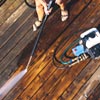Power Washing Techniques
For large cleaning tasks like buildings, walls, parking areas, heavy equipment, even statues, you need a power washer. Power washing is the preferred cleaning method for removing pollution and fuel emission residue; mineral, lime, and hard water deposits; grease and oil leaks; graffiti, and more.
 Because of the amount of power behind the process, an inexperienced
user can unintentionally cause a great deal of damage. In professional
hands, however, power washing is an efficient, effective cleaning
alternative, often saving money over more labor-intensive methods.
Power or high pressure cleaning is a directed blast of internally
heated water, often discharged at five gallons per minute, under
up to 3,000 pounds per square inch of pressure.
Because of the amount of power behind the process, an inexperienced
user can unintentionally cause a great deal of damage. In professional
hands, however, power washing is an efficient, effective cleaning
alternative, often saving money over more labor-intensive methods.
Power or high pressure cleaning is a directed blast of internally
heated water, often discharged at five gallons per minute, under
up to 3,000 pounds per square inch of pressure.
For specific cleaning and stain removals, certain chemicals or solvents are added. For specific or environmentally safe cleaning needs, there are several other blasting methods: With soda blasting, there are the advantages of being environmentally safe, and no pre-masking is required. It cleans multi-layered surfaces, as well as being non-corrosive and it is safe around food equipment.
Sand blasting is intended for jobs that require some stripping and abrasion.
Dry ice blasting shoots dense dry ice pellets that turn to a harmless gaseous substance on impact. This option leaves an instantly dry surface, and it is also safe around food equipment.
-- Tips courtesy of HomeAdvisor.com